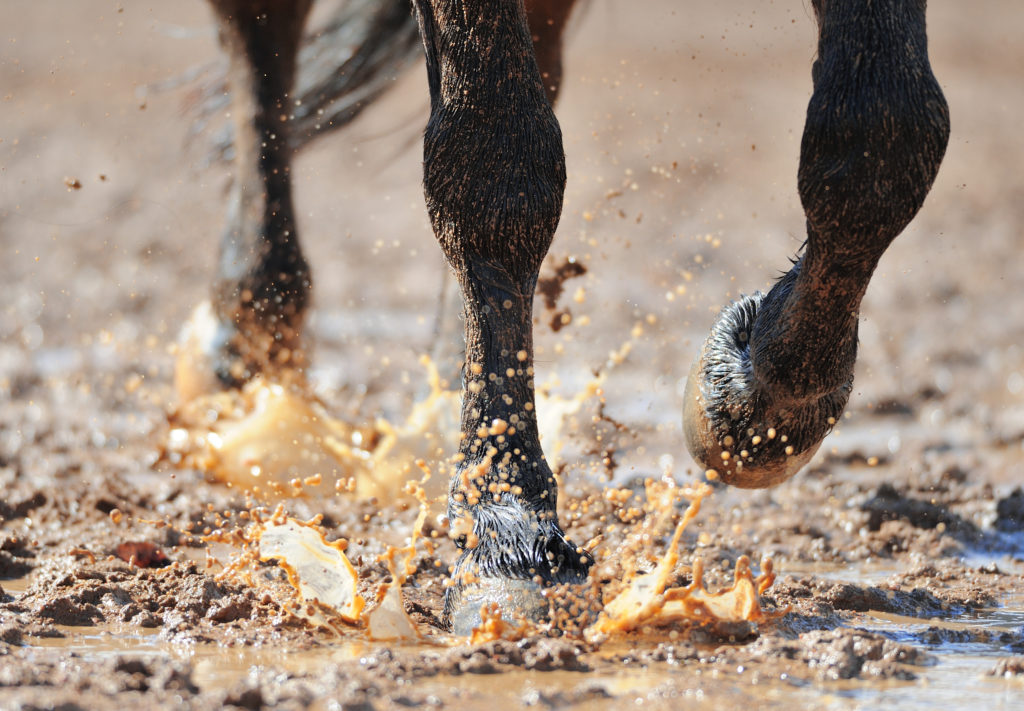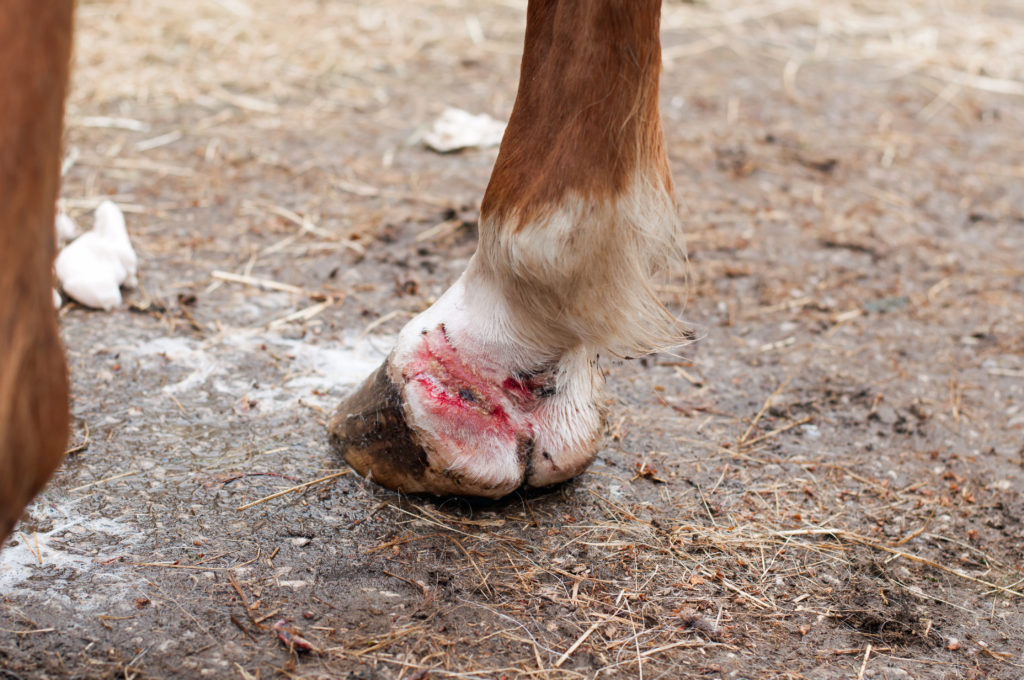Mud Fever
(AKA scratches, pastern dermatitis, greasy heal)
What is mud fever?
Mud fever is a very common skin condition that affects horses’ legs. Most cases are bacterial, but it requires other factors to damage the skin before it can develop. Horses typically get scabbing of the skin at the back of the pastern, but it can spread to involve large areas of the leg. It can be frustrating for horse owners and veterinarians alike, with some cases recurring or not responding to treatment at all.
What impact can mud fever have on your horse?
Most cases are mild, with minor scabbing on the back of their pasterns. Although there may be some discomfort due to the inflammation, these horses normally do not go lame from mud fever.
More susceptible horses can be badly affected, however. Mud fever can lead to deep tissue infection (cellulitis) which causes swelling of the limb, pain and lameness.
High performance horses can be badly affected even by mild cases of mud fever, particularly if they are required to perform for a long period of time. Endurance horses are a key example, and aggressive treatment and prevention are essential for these athletes.

Predisposing factors
Anything that breaks down the skin’s natural defences will predispose a horse to mud fever. Common scenarios include:
- Prolonged wetness of the skin. This causes the skin to soften, allowing bacteria to invade. The majority of mud fever cases occur in winter when it is wet and muddy.
- Feather mites (Chorioptes bovis), particularly in draft horses. They don’t cause mud fever by themselves, but the itchiness they cause makes the horse bite the skin under their feathers. Such damage to the skin makes it vulnerable to bacterial attack.
- An unbalanced/ deficient diet can cause skin dryness and cracking, leaving it open to bacterial invasion.
The immune system is also important as it allows an animal to fend off any bacteria that do manage to get past the physical barrier of the skin. Reduced immunity predisposes to developing mud fever and can occur because of:
- old age
- Cushing’s disease (AKA Pars Pituitary Intermedia Disorder, or PPID)
- poor/ unbalanced nutrition
- any kind of illness
Fine-skinned and pink-skinned horses also appear to be more susceptible. Many owners report that their horses’ white socks are more commonly affected by mud fever than their black/chestnut legs.
Mud fever: not simply one condition with one cause
The vast majority of mud fever cases are caused by soil bacteria attacking damaged skin. Although soil bacteria are to blame for the majority of mud fever cases, there are exceptions to that rule.
Skin that has been damaged by severe sunburn or by UV-induced vasculitis (pastern leucocytoclastic vasculitis) can experience severe mud fever once soil bacteria gain access and cause infection.
Fungi like ringworm and others can play a role if they cause enough skin damage, but they are normally only a minor contributor.
Why is it important to determine all the possible causes?
Taking care to establish the exact cause of your horse’s mud fever and tackling all contributing factors greatly improves the chance of a successful and lasting cure.

First-line care for mud fever
Remember that mud fever is often an ongoing problem, so it is important to manage it in a way that is not painful for your horse.
Softening scabs before you gently remove them is better than tearing them off, for instance. Scabs may be softened with an appropriate non-astringent product such as glycerine, udder cream or honey. Stable wrapping over the top for a few hours can help the scabs to soften as well.
Once scabs have been removed, ointment should be applied. Several products are available to choose from – select an ointment that is soothing and antimicrobial, and that doesn’t interfere with healing. Your vet will be able to point you in the right direction if you’re not sure.
Skin that is very sore after scab removal often benefits from bandaging, provided the dressing doesn’t stick to the wounds and bandage is kept clean and dry.
At what point should you ring a vet?
Firstly, it is never wrong to ring a vet if you are unsure or don’t feel confident doing something.
Having said that, there are some circumstances under which you absolutely should ring a vet. Some of those reasons include:
- If your horse’s mud fever is not responding to treatment and/or is worsening under treatment
- If the affected leg has become lame
- If the affected leg is beginning to swell
- If the horse resents treatment or is becoming dangerous.
Prevention of mud fever
Keeping horses out of mud wherever possible is very helpful. This is not always an option, unfortunately.
Feeding a diet that is rich in omega-3 fatty acids helps the skin to produce it’s own moisturiser, cerumide. Tackling any dietary mineral deficiencies with a good supplement is also important.
Getting rid of skin parasites, particularly Chorioptes feather mites, is important, especially if you have a draft breed.
Please don’t hesitate to contact Wanganui Veterinary Services if you have any queries regarding mud fever in your horse.
References:
Akucewich, L. (2005). Equine dermatology I: equine pastern dermatitis (EPD). Proceedings of the NAVC North American Veterinary Conference, 85-88
Chan, C.C-H., Pollock, P., Dowson, K., & Smith, A. (2016). A clinical trial to evaluate the use of an anti-bacterial dressing as a novel approach to treat chronic refractory equine pastern dermatitis (EPD). Proceedings of the European Veterinary Conference Voorjaarsdagen.
Gill, J.G. Cutaneous vasculitis in horses. Vetscript, May 2014, 22-23
Knottenbelt, D.C. (2008). Equine dermatology – the best chance of a diagnosis. Proceedings of the 30th Bain Fallon Memorial Lectures, 6-32
Knottenbelt, D.C. (2011). Some enigmas of equine skin disease. Proceedings of the 12th International Congress of the World Equine Veterinary Association
Pascoe, R.R. (1995). Equine alopecia – hair follicle disorders. Proceedings of 17th Annual Bain Fallon Memorial Lectures, 161-183
Vogelnest, L.J. (2013). Pastern dermatitis in horses – a challenge to manage. The Australian Equine Veterinarian, 31(1), 53-55


